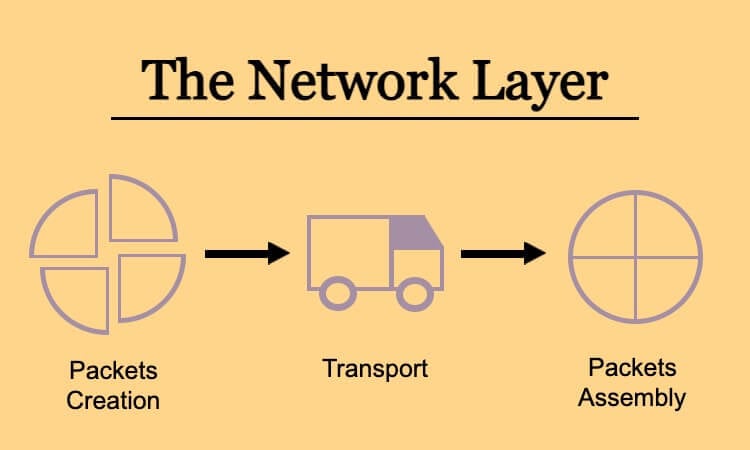What is the Network Layer?
The network layer is a critical component of computer networks, responsible for enabling communication between devices across different networks. In this comprehensive guide, we’ll explore what the network layer is, its key functions, and its importance in ensuring smooth and secure data transmission.
What is the Network Layer?
The network layer is a part of online communication that connects and transfers data packets between different networks or devices. As the foundation of the open systems interconnection model, the layer manages and selects the best logical path for data transfer between nodes. It assigns source and destination internet protocol addresses to each data segment. The primary responsibilities of this layer are logical connection setup, data forwarding, routing, and delivery error reporting. The layer can either support connectionless networks or connection-oriented networks. Encryption, connection checking, and routing processes happen at this layer and use several different protocols, including IP, IPsec, IPX/SPX, ICMP, IGMP, and GRE.

What happens at the Network Layer?
Anything that has to do with inter-network connections takes place at the network layer. This includes setting up the routes for data packets to take, checking to see if a server in another network is up and running, and addressing and receiving IP packets from other networks. This last process is perhaps the most important, as the vast majority of Internet traffic is sent over IP.
Key Functions
Logical Addressing (IP Addressing)
One of the primary functions of the network layer is logical addressing. In most modern networks, this is achieved through the use of IP (Internet Protocol) addresses. An IP address is a unique identifier assigned to each device on a network, allowing it to be recognized and communicated with by other devices.
IP addresses are typically represented in dotted-decimal notation (e.g., 192.168.0.1) for IPv4 or hexadecimal notation (e.g., 2001:0db8:85a3:0000:0000:8a2e:0370:7334) for IPv6. They are divided into network and host portions, enabling efficient routing and subnetting.
The network layer also distinguishes between public and private IP addresses. Public IP addresses are globally unique and assigned by ISPs, while private IP addresses are used within local networks and are not routable over the Internet.
Routing and Packet Forwarding
Another crucial function of the network layer is routing. Routing is the process of selecting the best path for data packets to travel from the source device to the destination device. Routers, the primary devices operating at the network layer, use routing tables and algorithms to make informed decisions about packet forwarding.
Routing tables contain information about network topology, including network addresses, the next hop (the next router in the path), and the interface through which packets should be sent. Routers exchange this information using routing protocols such as OSPF (Open Shortest Path First) and BGP (Border Gateway Protocol) to maintain accurate and up-to-date routing tables.
Routing can be static or dynamic. Static routing involves manually configuring the routing tables, while dynamic routing relies on routing protocols to automatically update the tables based on network changes and conditions.
Fragmentation and Reassembly
The network layer also handles fragmentation and reassembly of data packets. Each network has a maximum transmission unit (MTU), which determines the largest packet size that can be transmitted without fragmentation. If a packet exceeds the MTU, the network layer divides it into smaller fragments, which are reassembled at the destination device.
Fragmentation is necessary to ensure efficient data transmission and to avoid issues such as packet loss or network congestion. The fragmentation process adds overhead to the network layer, but it is essential for maintaining smooth communication between devices.
Error Handling and Diagnostics
The network layer is responsible for detecting and handling errors that may occur during data transmission. It uses protocols such as ICMP (Internet Control Message Protocol) to send error messages and perform diagnostic tasks. ICMP is used by tools like ping and traceroute to test network connectivity and identify issues.
Ping sends ICMP echo request messages to a target device and waits for a response, while traceroute maps the path taken by packets from the source to the destination, helping to locate routing problems.

Protocols at the Network Layer
While IP is the most popular and widely used protocol at the network layer today, there are plenty of other protocol examples to note. Network protocols at Layer 3 include those used for dynamic routing of networks, secure communications, network translations, and network redundancy. Here are a few examples:
- Open Shortest Path First (OSPF) is a dynamic routing protocol.
- Routing Information Protocol (RIP) is a dynamic routing protocol.
- Network Address Translation (NAT) translates and manages one IP address into another.
- Internet Protocol Security (IPsec) is a secure network protocol suite that uses authentication and data encryption.
- Hot Standby Router Protocol (HSRP) is a network path redundancy protocol.
- Virtual Router Redundancy Protocol (VRRP) is a network path redundancy protocol.
Summary
In this article, we have looked at the network layer. We have seen how communication is aided through logical addressing. We outlined the protocols in the network layer and discussed how networks are divided as well as how communication between hosts happens.